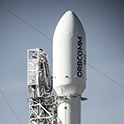Thanks to their now recently official reusability capability, and after looking at the SpaceX flight manifest that showcases at least five new v1.1 FT before the Demo, it made me ponder:
By the time of the planned Falcon Heavy Demo launch (May 2016), could SpaceX have enough 1st stages to possibly make a refurbished Falcon Heavy (ie: the hardware aspect would be covered)?
If it is possible, it would make sense for SpaceX would go down that road — that launch is paid for from SpaceX's own pocket (explaining why Falcon Heavy was pushed back when in 2014 they saw 1st stage recover was doable on paper). Also it could solve their client’s initial worries about the quality of their refurbished rocket.
Here it could put SpaceX in a position of strength saying "No rebates on refurbishments, we go by cost of launch only like we’ve always done. Expect the price to drop in the future though".
I’m asking to know if the added risk is worth it. Also to know if there are any science/practical reasons why it wouldn’t be doable. Examples that comes to mind are:
- Refurbishment time frame, knowing SpaceX's track record, is not realistic.
- the v1.1 FT would require excessive rebuild to accommodate 'Heavy' stuff (ex: cross-feed capability).


